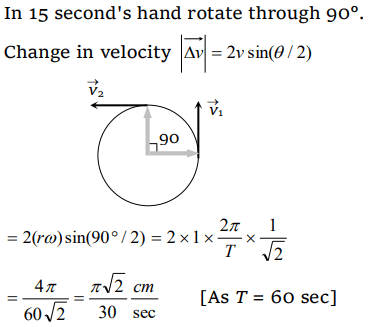1. A mass of 100 gm is tied to one end of a string 2 m long. The body is revolving in a horizontal circle making a maximum of 200 revolutions per min.
The other end of the string is fixed at the centre of the circle of revolution. The maximum tension that the string can bear is (approximately)
a) 8.76 N
b) 8.94 N
c) 89.42 N
d) 87.64 N
Explanation:

2. A road is 10 m wide. Its radius of curvature is 50 m. The outer edge is above the lower edge by a distance of 1.5 m. This road is most suited for the
velocity
a) 2.5 m/sec
b) 4.5 m/sec
c) 6.5 m/sec
d) 8.5 m/sec
Explanation:

3. Certain neutron stars are believed to be rotating at about 1rev / sec . If such a star has a radius of 20 km, the acceleration of an object on the equator of
the star will be
a) \[20\times10^{8}m\diagup sec^{2}\]
b) \[8\times10^{5}m\diagup sec^{2}\]
c) \[120\times10^{5}m\diagup sec^{2}\]
d) \[4\times10^{8}m\diagup sec^{2}\]
Explanation:

4. A particle revolves round a circular path. The acceleration of the particle is
a) Along the circumference of the circle
b) Along the tangent
c) Along the radius
d) Zero
Explanation: Along the radius
5. The length of second's hand in a watch is 1 cm. The change in velocity of its tip in 15 seconds is
a) Zero
b) \[\frac{\pi}{30\sqrt{2}}cm\diagup sec\]
c) \[\frac{\pi}{30}cm\diagup sec\]
d) \[\frac{\pi\sqrt{2}}{30}cm\diagup sec\]
Explanation:

6. A particle moves in a circle of radius 25 cm at two revolutions per second. The acceleration of the particle in \[m\diagup sec^{2}\] is
a) \[\pi^{2}\]
b) \[8\pi^{2}\]
c) \[4\pi^{2}\]
d) \[2\pi^{2}\]
Explanation:

7. An electric fan has blades of length 30 cm as measured from the axis of rotation. If the fan is rotating at 1200 r.p.m. The acceleration of a point
on the tip of the blade is about
a) \[1600 m\diagup sec^{2}\]
b) \[4740 m\diagup sec^{2}\]
c) \[2370 m\diagup sec^{2}\]
d) \[5055 m\diagup sec^{2}\]
Explanation:

8. The force required to keep a body in uniform circular motion is
a) Centripetal force
b) Centrifugal force
c) Resistance
d) None of the above
Explanation: Centripetal force
9. Cream gets separated out of milk when it is churned, it is due to
a) Gravitational force
b) Centripetal force
c) Centrifugal force
d) Frictional force
Explanation: Particles of cream are lighter so they get deposited near the centre of circular path
10. A particle of mass m is executing uniform circular motion on a path of radius r . If p is the magnitude of its linear momentum. The radial
force acting on the particle is
a) pmr
b) \[\frac{rm}{p}\]
c) \[\frac{mp^{2}}{r}\]
d) \[\frac{p^{2}}{rm}\]
Explanation:
